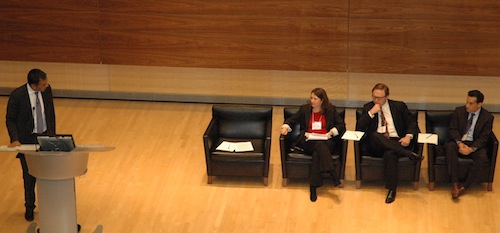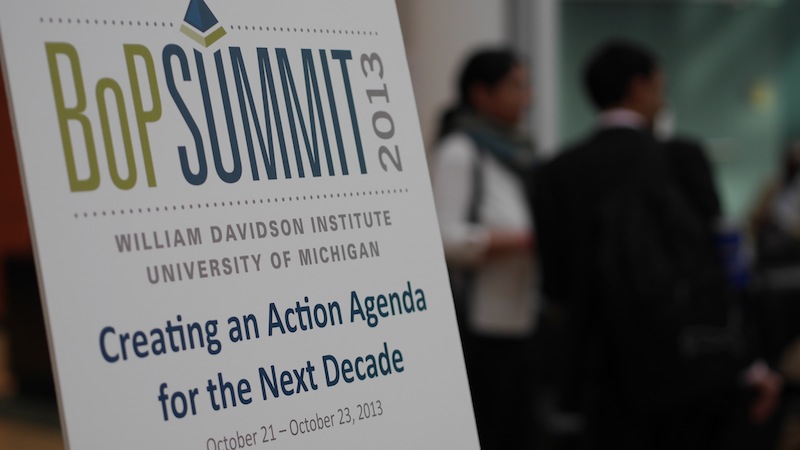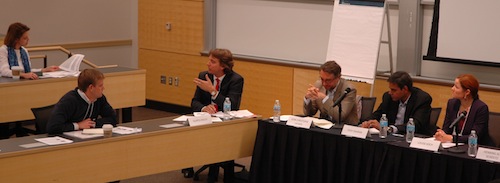Day 2 at the BoP Summit: Urgent, but practical, action
NextBillion is providing special coverage of the BoP Summit 2013: Creating an Action Agenda for the Next Decade, hosted by the William Davidson Institute. You can follow all the action at a special blog on NextBillion: nextbillion.net/bopsummit. On Twitter, please follow the hashtag #bopsummit for updates.
On Day Two, attendees of the BoP Summit took a more functional role – brainstorming solutions to the challenges facing BoP ventures today and starting to map the future path of this vital field that aims to lift people out of poverty.
The second day’s agenda included two sets of four concurrent sessions, and two plenary discussions on best practices, major roadblocks and next steps in the fields of agriculture and healthcare. Panelists as well as attendees took stock of the current BoP field, recognized and amplified critical success factors, identified on-going challenges, and explored how they can be overcome.
Near the end of the day, participants split into nine working groups to start charting a roadmap for the field.
But before that work began, they attended several interesting concurrent and plenary sessions.
The panel session, “Understanding the BoP: Building Ventures that Incorporate the Local Context,” started with a video (watch it below).
The video is a “day in the life” story that makes clear that the mother of the household maintains the home, does multiple chores, goes to work working in the field and prepares the family meals. The father of the household was the last to get up in the morning. And while he put in a full day as a laborer, he did very few chores around the house, and is the first one to go to bed at the end of the day.
One participant at the BoP Summit said he was surprised by the gender-based division of labor. That prompted a female participant to shoot back “it wasn’t surprising at all … that’s life … and not just for the poor.”
It was a humorous beginning as well as a bit of a Rorschach test.
When considering products and services to the base of the pyramid, a complicated matrix of questions follows. What does the family need, if anything, to improve their lives and incomes? How could this family’s arguably tenuous financial situation be enhanced through specific, value added products? And if so, what would be the result of those purchases on the family dynamics, the environment, their lives?
Madhu Viswanthan, professor at the University of Illinois, worked with a team to produce the video and moderated the panel. (Learn more about the Subsistence Marketplaces Initiative and explore more of their work here). Viswanthan, whose research includes a focus on poverty and subsistence marketplace behaviors, said the video was designed to generate these sorts of questions among participants, who later broke up into groups to talk about insights and challenges in delivering services to the BoP.
Panelist Olivier Kayser, CEO and founder of BoP consulting firm HYSTRA, said the issue of financial risk for low-income families is a constant barrier for purchases.
“How is it these families do not make these investments when they have the means?” he asked. “What if something goes wrong with the product? The effective marketers are those who have a holistic perspective” (in providing quality and product guarantees).
Fellow panelist Ehsan Noursalehi, vice president and creative director at Bump Nonprofit Design Studio, noted that not every product marketed to the BoP needs to be a complete life changer. BUMP is developing a low-cost prosthetic arm.
After watching the video, he observed that innovations could easily enhance the everyday. It doesn’t necessarily need to be massive infrastructure concerns.
“There can be very simple things that can add to improving the lives of the people,” he said.
While social entrepreneurs may think of themselves as “agents of change,” they need to realize their limitations. Entrepreneurs can be far more effective working with local shopkeepers and crafts people who are providing goods and services to the BoP, instead of trying to to replicate them, said Srinivas Venugopal, who led a technology-based social venture focused on delivering education services to low income consumers in rural Tamil Nadu, India.
“The biggest thing I had to do was to let go and to partner with local service providers who could bring more to the table,” he said.
Filippo Veglio, director of the social capital focus area for WBCSD, led the panel session on “Multinational Corporations and the BoP: Seeking Scale.”
The best way to achieve scale when serving the BoP, according to the principals of four international corporations which are trying to do just that, is to earn the trust of the community you’re serving.
Unfortunately, there’s no roadmap to earning that trust, because communities are constantly evolving and it’s difficult to bring all the interested parties together.
“This BoP market is really dynamic. You have to be aware of what’s going on,” said Henning Alts Schutz, who heads up marketing for Patrimonio Hoy, which builds affordable housing in Mexico and five more Latin American countries.
Vijay Sharma, general manager – rural for drug maker GSK, which has built a lucrative consumer health care segment in India, agreed, but gave a rule of thumb: “You can build brands by what you say or by what you do. What you do is most important.”
The panelists agreed on the need to earn trust outside their corporations, but not on their role within their corporations.
Sharma said his group started small and learned to co-exist within GSK. “You need to unlearn a lot” to successfully serve the BoP, he said.
Meanwhile, Jean-Christophe Laugee, social innovation and ecosystem director at Danone, said his group is more about changing the corporation than getting along: “Our challenge is not to co-exist but to transform mainstream practices. We’re going to exist as a new model.”
Louise Koch, program manager at Grundfos LIFELINK, in the pump manufacturing business, said her group is seen internally as a hybrid: “It’s a business with a social purpose, and without that social purpose we would have been shut down, because there are easier ways to make money.”
All of the participants came together for the healthcare plenary session. WDI Director of Healthcare Research and panel moderator Prashant Yadav said health care at the BoP is basically a blank slate on which plenty of players are scrambling to leave their mark.

The problem is not the number of providers, but the quality and cost of the care.
Fortunately, she said, there are about 1,200 innovative health care service and financing models – many centered on universal health care – that warrant study. She said key questions are: “How do we get quality models to scale?” and “How do we shape this model in health financing so it creates opportunities for entrepreneurs?”
John Simon, managing partner of Total Impact Investors, said there are opportunities for health care investors in Africa, where the middle class is growing rapidly and most funding currently comes from the private sector. But it’s complicated because all facets of the health care supply chain have to be considered: workers, payment systems, equipment, etc.
That wasn’t news to Marc Kerachsky, director of New Market Models for GE’s Healthymagination, who’s looking for ways to improve health care affordability, access and quality worldwide, and seeking partners. “Nobody’s going to do this alone,” he said, “particularly at the bottom of the pyramid.”
Like other panel sessions, discussion at the “New Venture Development: Incubation to Acceleration” session veered from inspiring success stories to frustrating unsolved challenges.
Radha Basu, CEO of iMerit and Co-Founder of Anudip, talked about Anudip’s market-aligned skills training, which addresses mass employment in India through rural IT and other skills training. With 90 percent job placement in the last 12 months and support from Omidyar Network that will help it scale its training programs and services to reach tens of thousands more people, Basu spoke effusively about the future.
“For the first time, I feel like we’re firmly planted in the social and financial – every decision we make takes both into account,” she said.
Nancy Wimmer, managing director of microSolar, was similarly enthused. Her company has helped make Bangladesh a solar success story, with 8 percent of the rural population benefiting from solar energy. Their secret – living and working with the people they serve.
“We’ve got 12,000 employees,” she said proudly, “but only 92 work in our head office. The others live and work in our 1,500 branches throughout Bangladesh, in rural villages – and each branch gives full services.”
Full service is a must in rural business, she said.
“You need to finance customers who don’t have cash, a bank account or credit, you must have engineers/technicians to install, maintain and repair the systems, you must train customers and their whole families to use solar home systems, and to take care of them,” Wimmer said. “And without innovation, you cannot survive in rural business, because you don’t know what’s going to happen from month to month.”
Donn Tice, chairman and CEO of d.Light, also shared some good news: market penetration for solar energy is doubling each year. But the bad news: it’s currently just at 4 percent.
He had some frank advice for companies working on similarly uphill battles to sell products to the BoP.
“People at the BoP have been the beneficiaries of a lot of crap products that came from people they can’t trust,” he said. “They’ll make an investment in your product if it serves a need, but the product had better do what it says. So first, you have to create trust, give them a chance to try the product and satisfy themselves that it’ll produce a return for them.”
Toward the end of the panel, an audience member asked a revealing question: “As BoP businesses you want to create competition that’ll serve more people. But you’re also a business and you want to protect your market share. How do you deal with that tension?” The silence that followed grew a bit uncomfortable.
One of the afternoon panel discussions was “Providing Financial and Other Resources: Re-thinking the role of Enterprise Support.”

Thane Kreiner, executive director, Center for Science, Technology and Society at Santa Clara University, said tech innovation isn’t enough. You need an appropriate business model to reach scale and affect people’s lives, and implementing a model requires an understanding of local context. But often there’s no entrepreneurial ecosystem in local contexts, so we’re still working on that.
“The question that keeps me up at night: Why aren’t there global scale social enterprises if there are 2 billion people that need the products they sell?”
Katherine Lucey, founder and CEO of Solar Sister, said the way to sell to the BoP is to provide your products or services at their doorstep, to meet them where they live. But social enterprises are often trying to distribute products that people don’t want yet in places with logistical challenges and a workforce that they need to train.
Supporting this kind of business requires a lot of patience from funders, an acceptance of lower returns and more risk. And the unresolved challenge is that the closer we get to building financially sustainable enterprises, the farther we get from serving the real base of the pyramid – the people with the most need.
Most of Day Three of the summit will be devoted to building an agenda to move the BoP domain forward for the future. Under the direction of the summit leadership team, participants will be divided into nine working groups to create a roadmap for the future development of the domain, and build connections with colleagues from across the globe.
Here are the nine working groups:
-
Multinational Corporations and the BoP: Seeking Scale
-
Non-Profits and BoP Ventures: Integrating Economic and Social Goals with Viability and Scale
-
Understanding the BoP: Building Ventures that Incorporate the Local Context
-
New Venture Development: Incubation to Acceleration—View from the Field
-
Providing Financial and Other Resources: Re-thinking the Role of Enterprise Support
-
Ecosystem Creation in Base-of-the-Pyramid Markets
-
Building Institutions to Facilitate Enterprise Growth
-
Achieving Social Performance: Assessing and Enhancing Poverty Alleviation Impacts
-
Best Practices, Major Roadblocks, and Next Steps: Agriculture
But before work on the roadmap begins, summit participants will attend a unique plenary discussion, “Funders’ View: From Ideas to Action.” A panel of prominent funders who are familiar with the BoP domain will reflect on what they have heard at the conference, provide insight into what projects they think are fundable, and participate in shaping the roadmap.
The panelists are: Patrick Fine (COO, FHI360; formerly VP of Millennium Challenge Corporation); Alonzo Fulgham (VP, Strategy & Sustainable International Development, CH2M HILL; formerly Acting Administrator, USAID); Eriko Ishikawa (Global Program Manager, IFC); Graham Macmillan (Senior Program Officer, Citi Foundation); and Jin Wakabayashi (Director, Private Sector Partnership Division, Japan International Cooperation Agency).
WDI Senior Research Fellow and conference organizer Ted London, who will moderate the panel discussion, said the funders’ participation is vital because with the BoP roadmap, a commitment of leadership is needed but so is a commitment of financial resources. He said the purpose of having funders talk about projects that can work isn’t to throw cold water on plans or constrain possibilities, but rather to “funnel energies and frame ideas in a way to maximize success.”
Afterwards, participants will return to their working groups to finish their work. To close out the summit, all nine working groups will give a short presentation of their action agendas. London will then outline the next steps to continue the discussion.
This post was written by NextBillion Editors Scott Anderson, James Militzer, and Kyle Poplin.
- Categories
- Uncategorized

